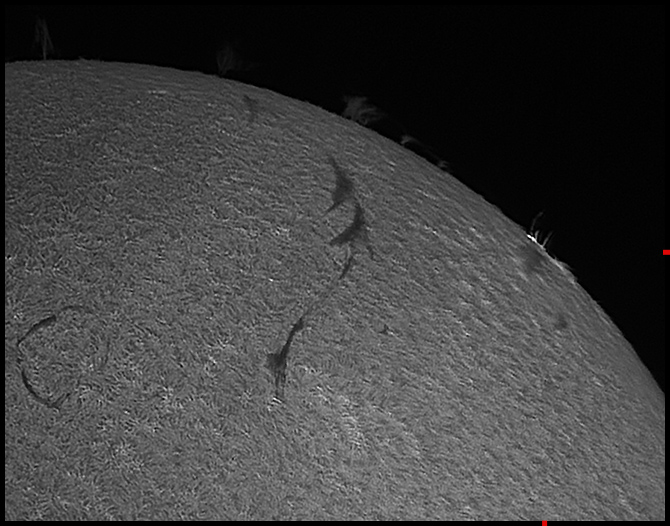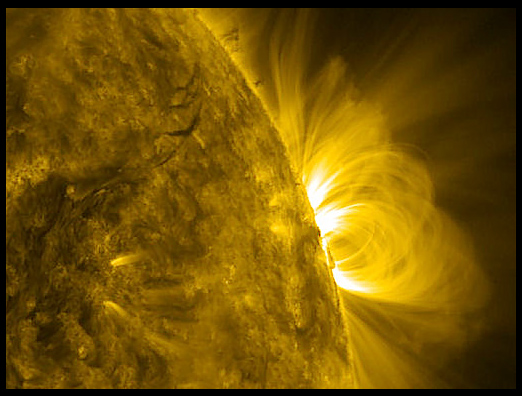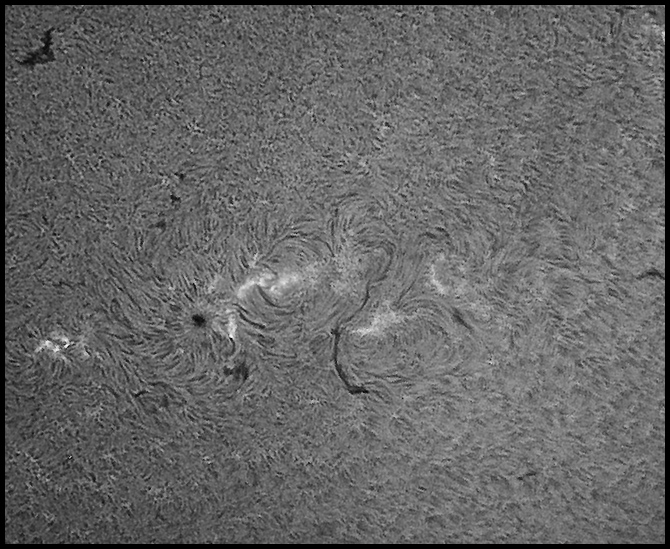|
Unlike many images on this website where the Sun's limb and disk are exposed or at least processed individually, this 300-frame distillation has been processed only once, as a whole, to show the relative brightnesses of assorted phenomena. The red tick marks indicate the position of AR 1429 just now coming back into view. Compare the brilliant plasma lofted along strongly curved magnetic field lines to the dimmer prominences above and left:
Here's the SDO (Solar Dynamics Observatory) image of the same region of the Sun at about the same time. I've rotated it to approximate the orientation of the image above. My image isolates the 6562.8A line of excited hydrogen; the SDO image uses the 171A line of Fe IX (8 times ionized iron):
And, just because I could, here's AR1445, a much less energetic sunspot group I've been watching cross the Sun's face. I got a kick out of the smoky, concentric presumably magnetic rings encompassing the brightest region:
03/30/2011. Oh, man! You learn something new every day, said the horse! Is this one of those commands that everyone else knows, or is it something relatively obscure within recent Windows that I can pass along to you, too? (I'm using Win7 64b Home Premium, FWIW.) So there I was, collecting gigs of solar data and thinking I didn't want to fill up my work disks with AVI files that I might or might not want to revisit after distilling them down to high-res images. I thought, wouldn't it be nice if I could just move all those AVI's over to their own disk, preserving the directory structure so that I wouldn't just have a pile of similarly named files ("sun_002.avi" etc) in one big heap. So do this: robocopy g:\photo_related\Astronomy e:\astrofiles /S /MOV *.avi That's robocopy source destination /do-subdirectories-too /move-don't-copy wildcard.filetype and didn't it work a treat! I moved all my solar and my few lunar AVI's off my G: drive onto a 250GB USB portable drive. 285 files in 50 directories, 92.1GB. Eventually, I'll surely move them to their own TB drives, because as long as this solar observing fetish lasts, I'm collecting 1-3 GB every clear day. This surely makes more sense than trying to save AVI's by moving them to DVDs which I did with days of effort once (once!) last year (where did I put those things?).
04/16/2012. After a hiatus, I was goaded outside by news of a massive eruption on the eastern limb of the Sun. This is what I found late in the afternoon -- remnants of a titanic explosion. More to see soon as this active region rotates into full view [Ha! missed it. The explosive eruption was north along the limb from this large but quiescent prominence]:
Disk: 3.4ms x 300, gain 15db
|
:: top ::
© 2011, David Cortner



